The main goal of Semrush’s Backlink Audit Tool is to help you identify as many toxic links for your domain as possible. The Audit tab of this tool lets you comb through your entire backlink profile (up to 500 backlinks per referring domain) and take action if necessary.
Reviewing Your Links
A number of factors go into Semrush’s definition of toxic, but some of the most common signals are links from spammy sites, links from non-Google indexed sites, and sites with malware or viruses. Basically, any unnatural link that might cause harm to your domain’s ranking in Google is considered a toxic backlink.
Once you have configured your Backlink Audit Tool, your backlinks will be listed in a table with three groups to move them between: For review, Whitelist, and All links.
You can also set your Backlink Audit to the page and subpath level when you click on your report scope.
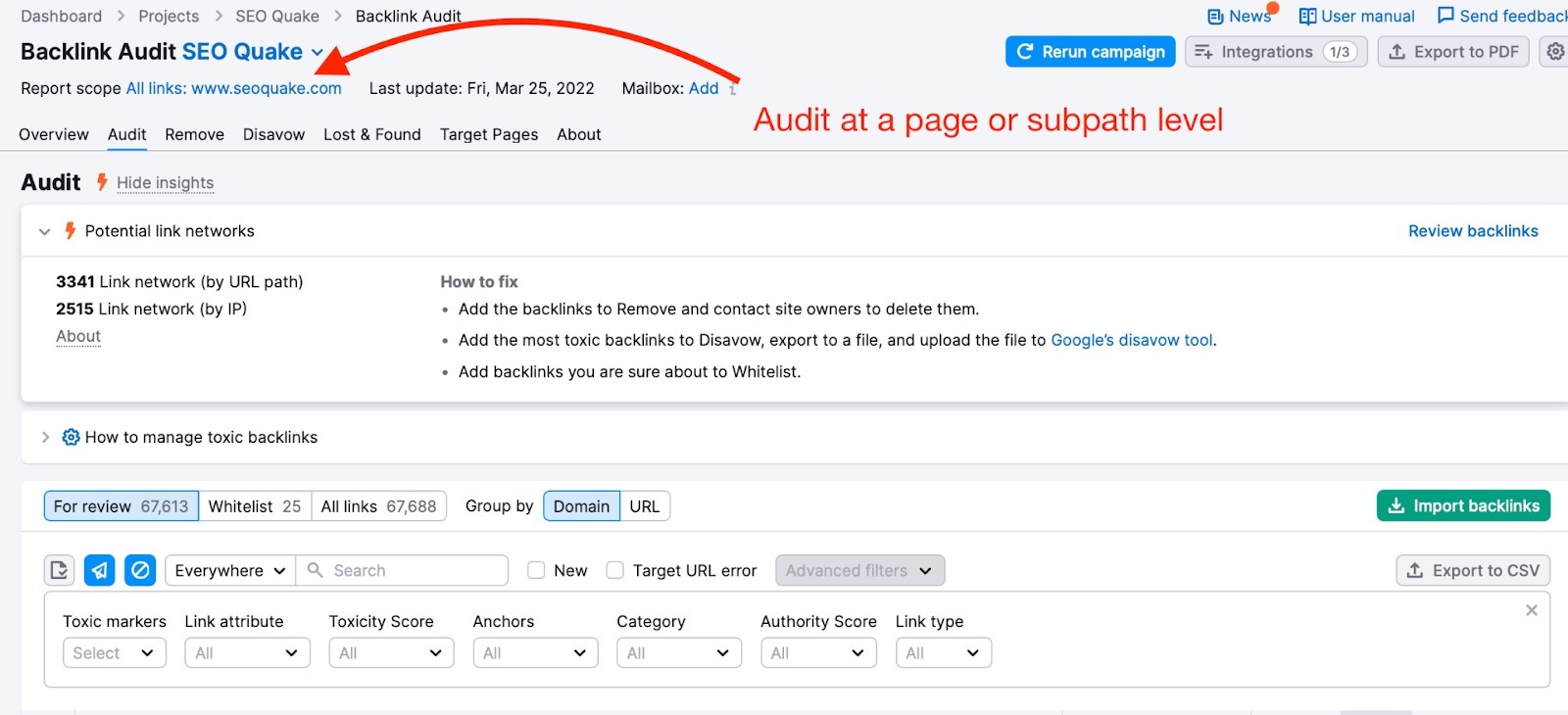
At the start, you will have all of your links in the "For Review" group. This group can be considered your working folder—the links that you are currently auditing. The "All links" group will be there as your backup, as these links will always remain in your audit in the case of a mistake. However, keep in mind that once you disavow any of these links they will disappear from BOTH folders. Disavowing is essentially suggesting to Google to not consider the impact of these links at all when reviewing your site.
You can see which of your backlinks are new by clicking the "New" checkbox. A backlink is considered new if less than a month has passed since the first time Semrush discovered it.
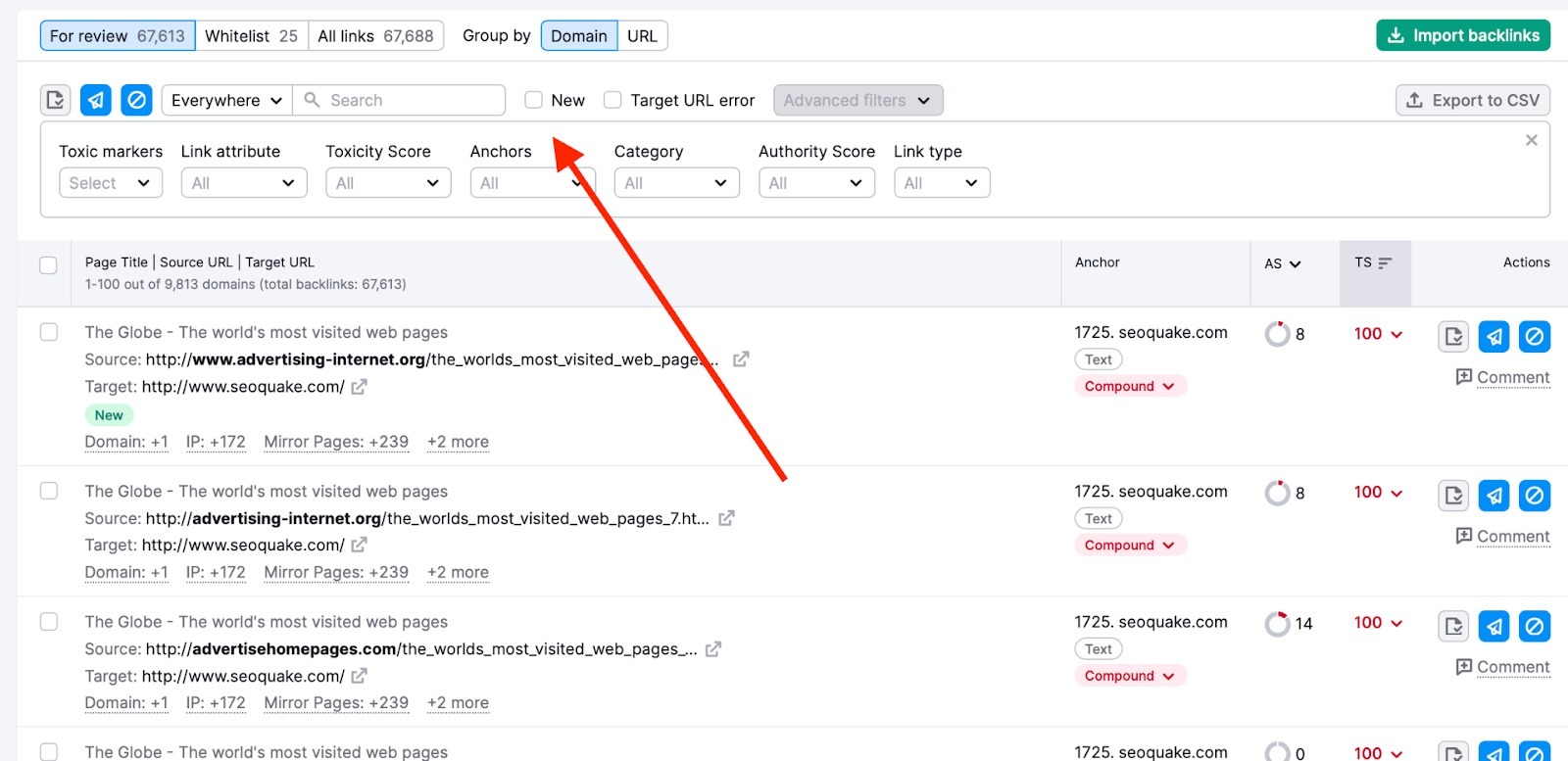
Import Backlinks
If you have a list of backlinks that you want to add to the audit report, you can upload it manually using the csv format.
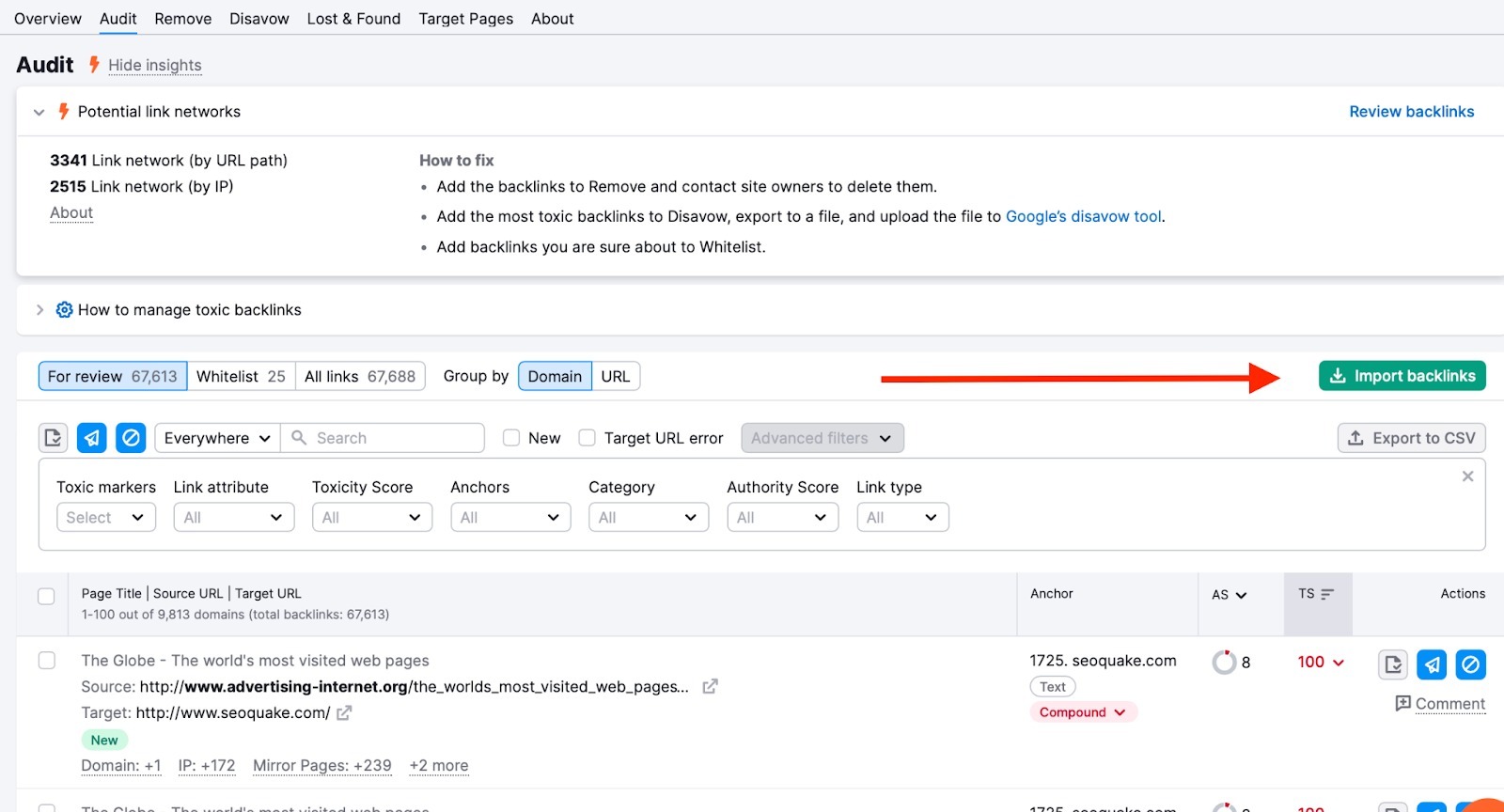
The tool will need some time to crawl the backlinks from the list. Once the import has started, the process cannot be stopped from the interface.
Please note that the backlinks which are wrapped in Javascript or don’t respond with the 200 HTTP status code won’t be added to your audit campaign.
Domain and URL
Just below these three groups of backlinks, you will notice there is a filters tab, and to the right, there are two labels: Domain and URL. The group of domains will include backlinks tied to a referring domain, while the URL group will allow you to see the individual URL of your backlinks. This is beneficial if you know the particular URL that is potentially harmful. The search bar directly below the labels will also give you the chance to search by URL, Page Title, and Anchor text.
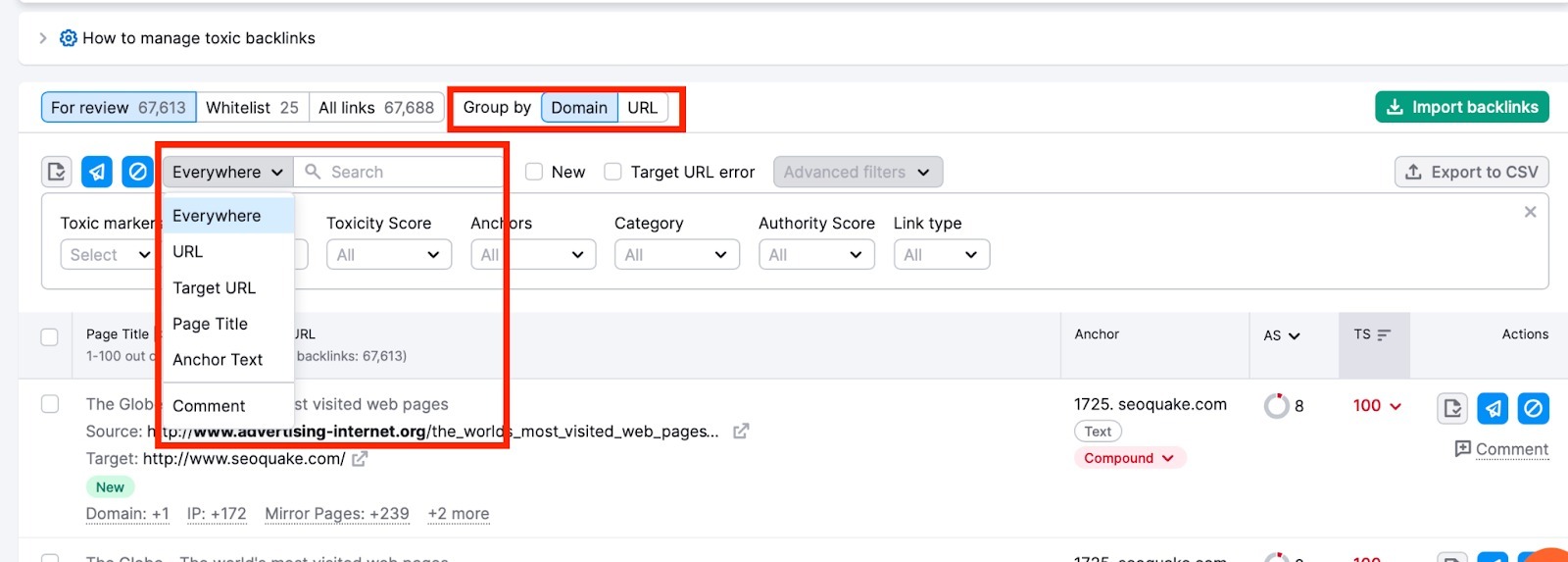
Additional info Column
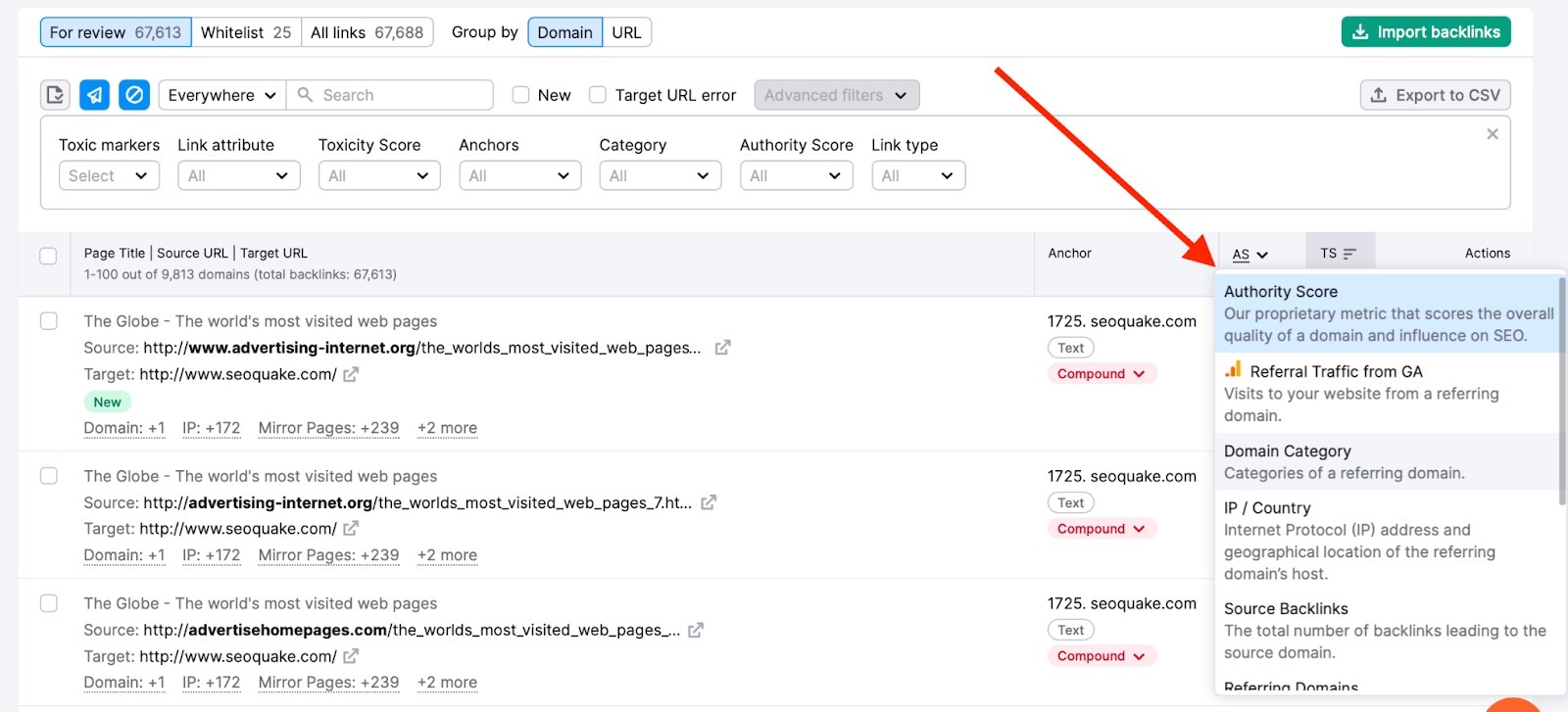
There is a column in this table that lets you choose between different metrics to display:
- Authority Score - our proprietary metric used to measure the overall quality of a domain and its backlinks’ influence on SEO. Read more about Authority Score.
- Referral Traffic (after connecting Google Analytics) - visits to your website from a referring domain over a period of 30 days since the last time you updated your Project.
- Domain Category - categories of a referring domain
- IP/Country of referring domain - Internet Protocol (IP) address and geographical location of the referring domain’s host.
- Source Backlinks - the total number of backlinks leading to the source domain
- Referring Domains - the total number of referring domains pointing to the source domain
- Keywords - the number of keywords bringing users to the source domain
- Monthly Visits - the number of unique visitors to a referring domain over the last month
- First seen date - the date when Semrush first discovered the backlink.
These metrics, in addition to Toxicity Score, can help you analyze the quality and trustworthiness of backlinks.
Referral Traffic = n/a
If the number under the Referral Traffic column says n/a next to a link in your table, this means that there is no information in your Google Analytics regarding the referral traffic from that domain over the past 30 days from the date that you last updated your Project.
Toxicity Score
The Backlink Audit Tool sorts the toxic backlinks in order of Toxicity Score, with the highest Toxicity Score links being shown on the first page. Toxicity Score is how the Backlink Audit Tool determines which of your links are the most urgent to investigate. Toxicity Score is based on a scale of 0 to 100, with 0 being good and 100 being very toxic.
There are currently 45+ different Toxic Markers that Semrush uses in determining the Toxicity Score for a link. By hovering over the Toxicity Score you will be able to see specifically which Toxic Markers are associated with that specific backlink.
You can use a backlink’s Toxicity Score to help decide what action you need to take. If you see a number of backlinks that appear to have a high Toxicity Score you will want to investigate them thoroughly. After serious consideration, you can send them to your remove list (to manually ask for removal) or your disavow list. A disavow list can be sent to Google so that you can request the links to be disassociated from your website.
To keep things clean in Backlink Audit, you can create a whitelist that includes domains with a low toxicity score or that you know to be natural and safe. Once you have created your whitelist, you will be left with domains that are deemed to be toxic.
Currently, moving links to the Whitelist doesn't affect your overall Toxicity Score in Backlink Audit. The key reason for this is that the whitelisted domains/links will still trigger Toxic Markers which may negatively impact your overall Toxicity Score.
The score in Backlink Audit will be recalculated if you confirm that you have disavowed toxic backlinks in Google Disavow Tool or if Backlink Audit doesn’t find your toxic backlinks after a recrawl. You will find more information about the disavowing procedure in the article Disavowing Your Backlinks.
Both of these actions (Disavow and Whitelist) can be done with buttons underneath the action tab to the far right of the backlink.
You may notice that you’re given the option to send full domains as well as just URLs to disavow. If you’re certain that all of the pages on a domain are directly affecting your SEO negatively, you might want to disavow them at the domain level. This ensures you aren’t risking missing other potentially toxic links from that domain.
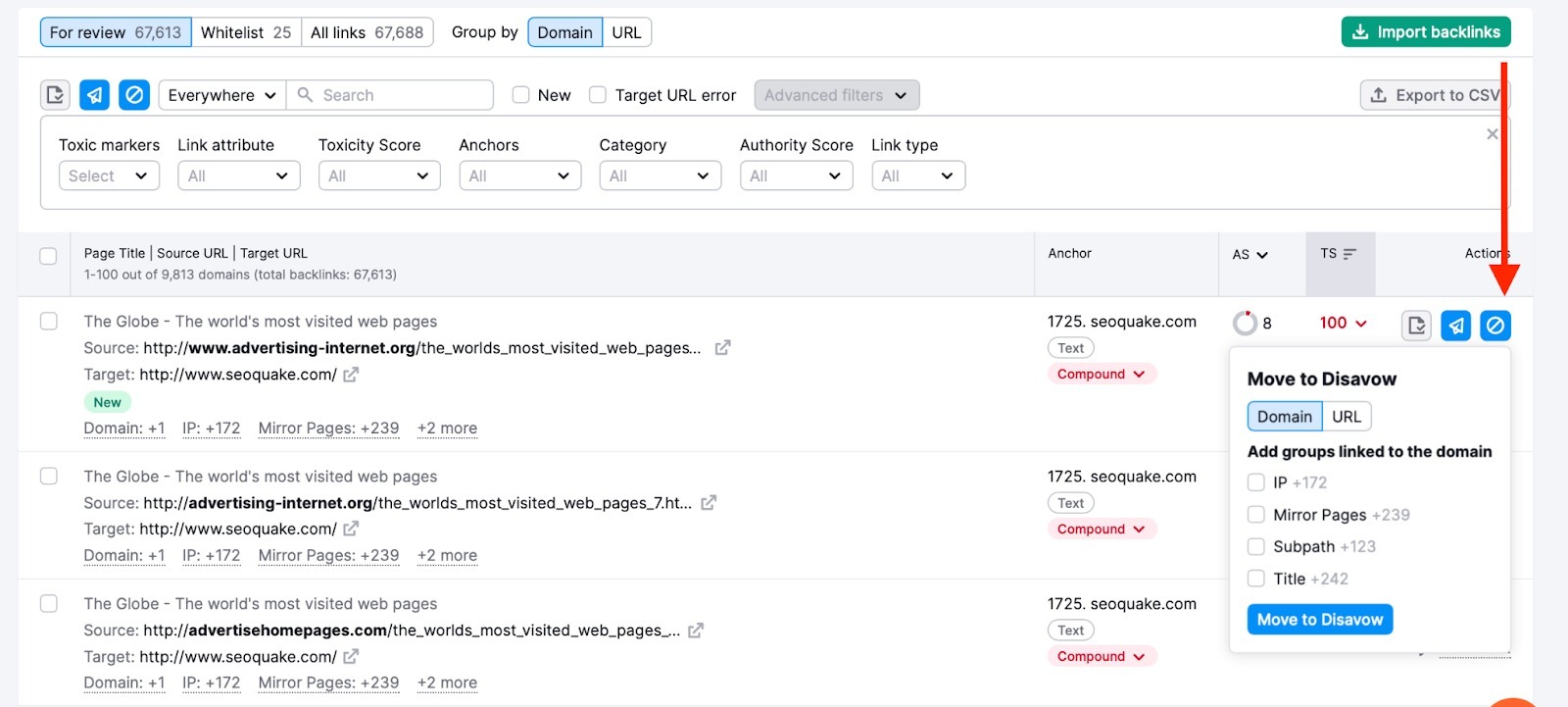
You are also able to view your backlinks as groups. The Backlink Audit Tool lets you group backlinks by both Domain and URL. This can let you save time if you know you are looking to just disavow whole domains.
Using Filters To Increase Your Audit Accuracy
By using the Toxic Marker filters you’re able to narrow down your list of audited backlinks to those that have a higher priority for your specific goal. Let’s say you’re looking for any backlinks that are coming from pages with spam TLDs, you can easily select that specific marker and the Backlink Audit tool will filter out your results to show you just the links Semrush found coming from pages with potentially spammy TLDs.
You are able to easily filter by new backlinks by clicking on the new checkbox next to the filter search bar. Not only that but you can also see links that have a Target URL Error.
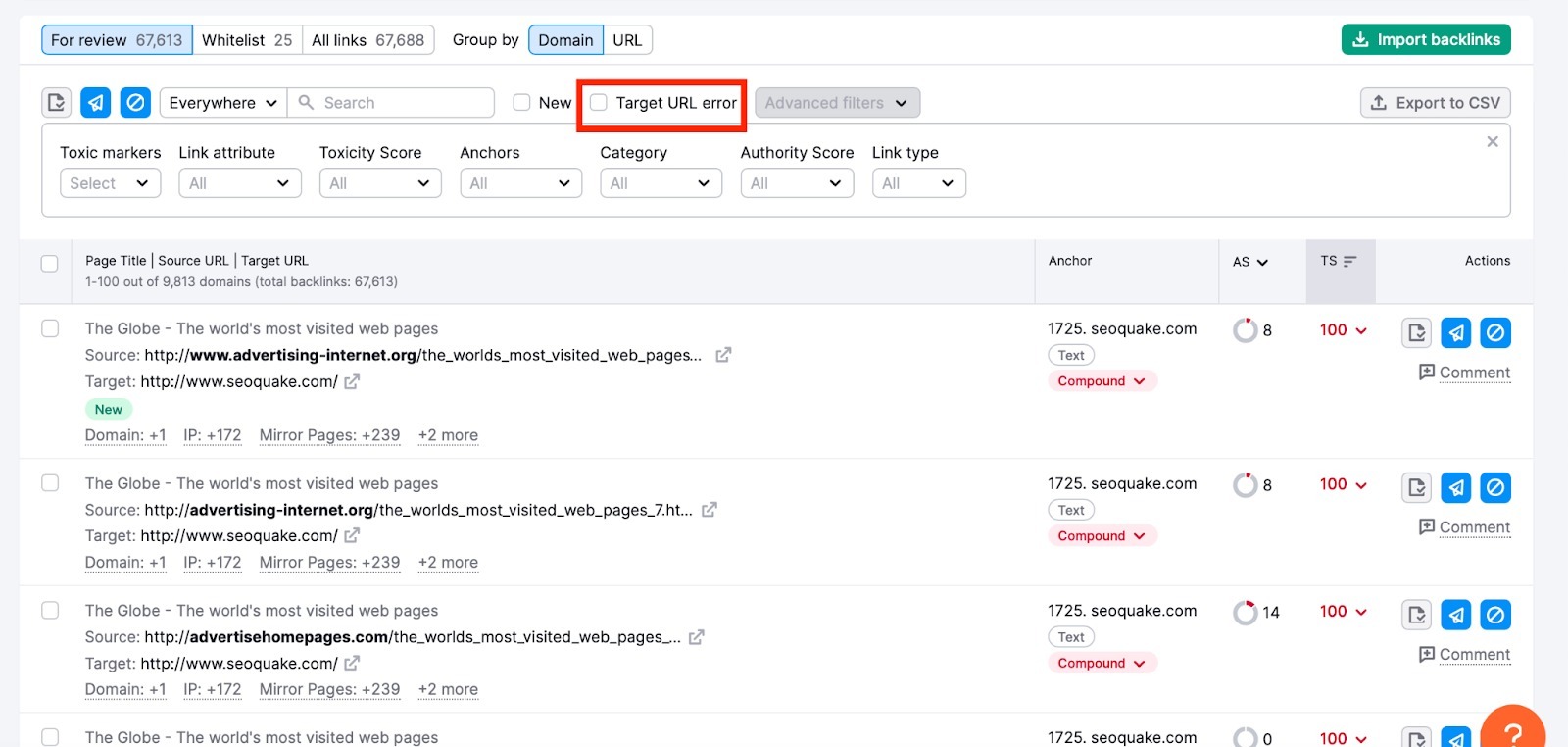
The Target URL Error filter lets you look for links in your profile that lead to broken pages. This will make it easier for you to see the pages that need to be fixed or that need a redirect.
Building Links from a Competitor’s Broken Links
If you happen to find a broken page on your competitor’s backlink profile you could use this as a way to contact that site owner and request they update that page to a link on your site with similar content. Take note of the domain and add it to your Link Building Tool workflow to stay organized.
Advanced Filters
Advanced Filters allow you to narrow down your results based on more than just toxic markers. Under the advanced filters dropdown menu, you can filter by Toxic markers, Link attribute, Toxicity Score, Anchors, Category, Authority Score, and Link type.
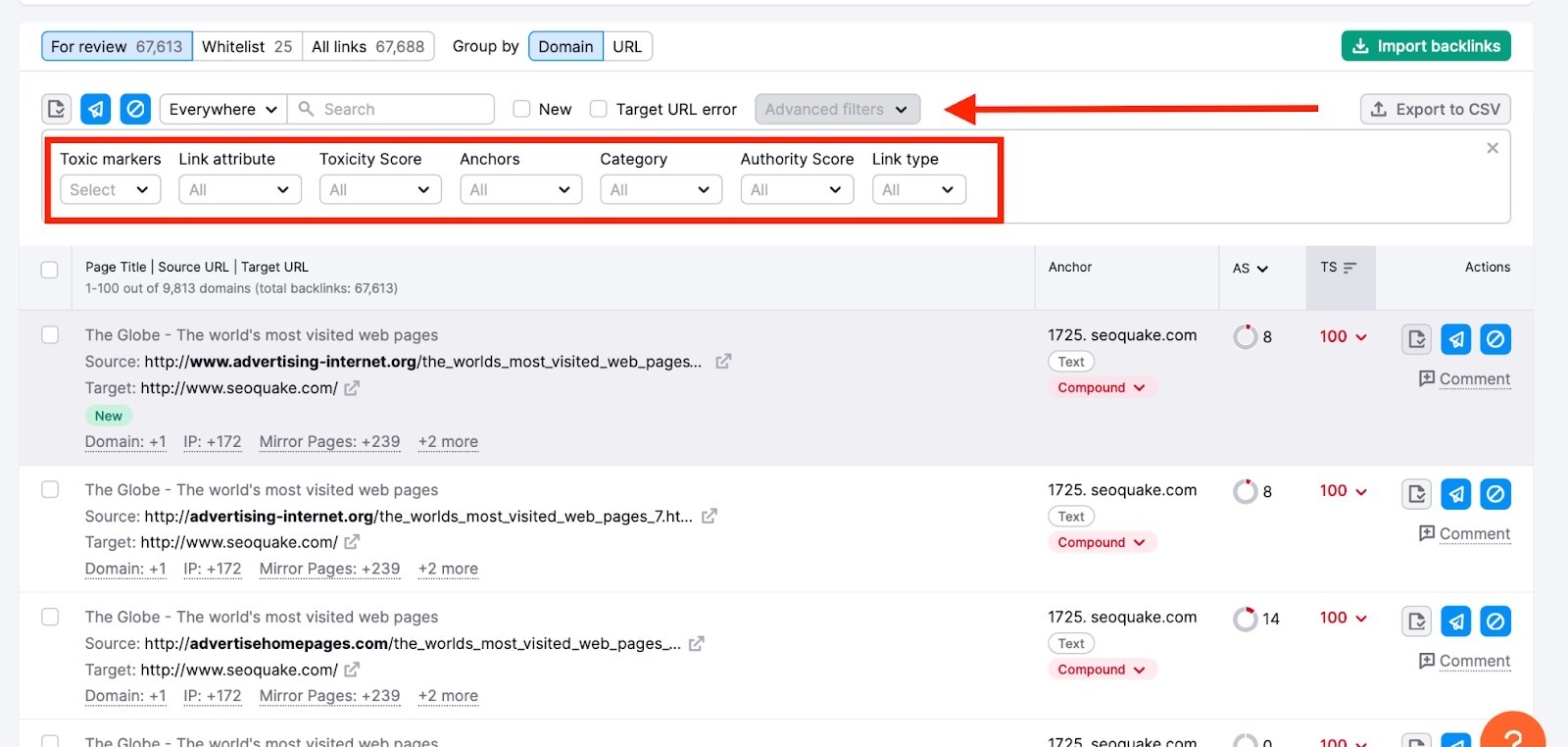
Toxicity scores are grouped into three categories:
- Toxic
- Potentially Toxic
- Non-Toxic
This can help save you time if you are looking to just analyze the list of backlinks that might be toxic to your overall profile.
Link Attributes are grouped into the following four categories:
- Follow
- NoFollow
- Sponsored links
- UGC
Click on any of these groups and your backlink data will be filtered out accordingly.
Anchors
The Backlink Audit Tool also groups backlinks by their corresponding anchor text. These anchors include:
- Money
- Compound
- Branded
- Organic
- Other
- Naked
- Empty
Branded anchors are anchors that include your brand's name. Naked anchors appear just as it would in the URL. Money anchors contain keywords the site is attempting to rank for. Compound anchors contain the brand name as well as another keyword. Organic anchors contain generic keywords such as “click here” or “this site.” Other anchors are those anchors not clearly defined and empty anchors are just that, empty.
When building links for SEO, it can be beneficial to have a percentage of your backlinks using your target keyword as the anchor text. By filtering out your audited links by anchor text you can help to gain those links that have the specific anchor text you are looking for.
After you’ve gone through all of your links in the audit tab and sent them to your disavow, whitelist, and remove lists, you can move on to the next step of your audit.
Profile Insights
The Profile Insights feature is designed to make your backlink audit a little easier by providing actionable tips that might help improve a domain's backlink profile. It can be found in each report.
Here it is from the Overview tab: 
Profile Insights offers its recommendations in three different groups:
- Red Flash: This group flags crucial issues that might impact your backlink profile and need to be reviewed.
- Orange Flash: This group alerts you of things that could be improved to potentially make your backlink profile stronger.
- Blue Gear Icon: Offers tips and recommendations for how to configure the Backlink Audit tool, to ensure more accurate results and to make the tool easier to use.
Issues flagged by Profile Insights will include a brief explanation, illustrating what the issue is and why it may be relevant for you, and a blue call-to-action button. Clicking on the blue button will take you directly to the report, chart, or page within Backlink Audit where you can see the issue for yourself and investigate it.
Next article: Removing Your Unwanted Backlinks.